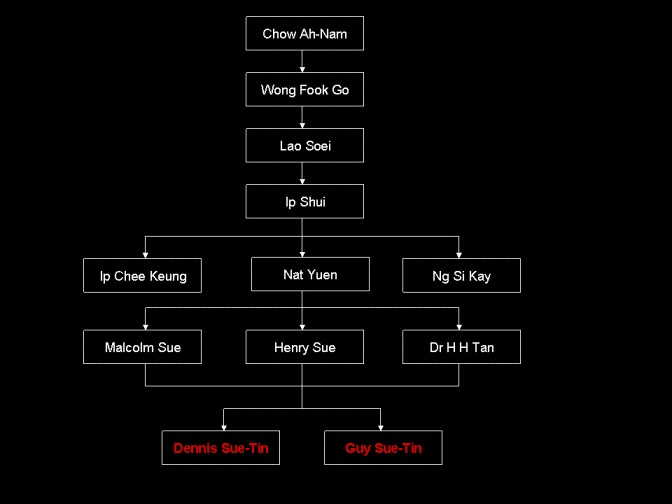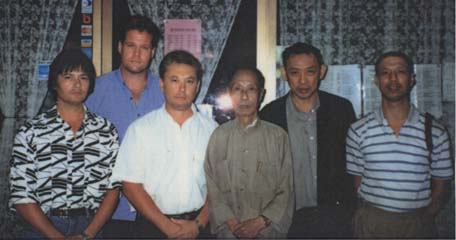
|
Chow Gar HistoryBefore the history of Southern Praying Mantis kung fu (Chow Gar Tong Long) is outlined, it should be noted that as with all styles, the story varies from school to school. Each school will always have its own interpretation of their style's history. The schools of Chow Gar are no exception. The history described below can be thought of as the "legend" of Chow Gar and may not be accurate historically. There are suggestions that Chow Gar was actually developed by members of the Ming royal family who fled to the South Shaolin temples during the Ching conquest of China in 1644. In Shaolin, the Ming rebels cultivated a style that could be learned rapidly and that would be effective against the Ching warriors. It was then taught to members of secret societies (triads) with the goal of overthrowing the Ching rulers. It is likely that the true history of Chow Gar will never be known, since no-one today was actually around when the style was "invented". Thus we can only speculate and go by what our teachers say. This is the Australian School of Kung Fu and Tai Chi's brief version of what happened back in the days of Chow Ah-Nam, founder of Chow Gar. The history of Chow Gar Tong Long traces back about 300 years. There was a man named Chow Ah-Nam who suffered from a debilitating stomach illness in his youth. One day his father sent him away, hoping that Ah-Nam would find a good doctor to cure his illness. So it was that Ah-Nam set off with his old servant to Northern China. Due to the long and tiring journey, both of them collapsed and became very ill. Worst of all, the old servant died not long after. After burying his old companion, Ah-Nam found that his money had been used up and his livelihood was at risk. Fortunately, an innkeeper agreed to find Ah-Nam a job. Not long after, the innkeeper introduced Ah-Nam to a nearby Shaolin temple as a helping hand for their kitchen. The next day, Ah-Nam thanked the innkeeper and set off for the Shaolin temple. During those days, it was compulsory in the temple for everyone to train in Shaolin kung fu for at least two hours a day. This was to Ah-Nam's benefit since once he started training, his illness seemed to become better every day. Ah-Nam gradually found himself involved deeply in the training of martial arts. One day, Ah-Nam happened across a malicious character, Monk Set. One day, Ah-Nam accidentally bumped into Monk Set who reacted by attacking Ah-Nam. Ah-Nam was quite skinny and short and although he tried his best to fight Monk Set, Ah-Nam was eventually defeated. A few weeks later, Ah-Nam left the Shaolin temple and went out for a walk. When he came across a river, he heard the sounds of a sparrow. Curiosity pushed him to locate the spot from where the sounds originated. Not far from the river bank, Ah-Nam saw a sparrow preying on a tiny mantis. The sparrow started to poke its beak at the mantis. Like a sudden flash of lightning, the mantis struck out with its pair of saw-like arms, cutting the sparrow near its beak. This took the bird by surprise and it flew off with a squawk of pain. Ah-Nam was amazed by the speedy strikes that the little insect performed and very surprised to see that such a tiny insect could fight off an enemy almost ten times its size. Ah-Nam realised this must be a sign from the heavens. Therefore he quickly located some mantises and took them back to his room at the temple. For days, months, and years, Ah-Nam indulged himself in finding out how the little insects fought. Ah-Nam constantly poked the creatures with sticks, making them fight each other. By doing so, Ah-Nam gradually managed to observe and analyse the offensive and defensive moves made by the insects. Aided by his Shaolin kung fu knowledge, Ah-Nam was able to formulate some very useful techniques based on the insects' fighting style. One day when Monk Set again challenged him, Ah-Nam realised that the time had come for him to test out all he had discovered during the last three years. Ah-Nam this time used the high-speed mantis techniques he had developed, completely overpowering Monk Set. The noises of the fight attracted the attention of the temple Abbot, Sim Yan. When Sim Yan saw the amazing new techniques used by Ah-Nam, he was overwhelmed. The Abbot immediately stopped the fight and asked who had taught Ah-Nam the strange techniques. Ah-Nam told Sim Yan about his encounter with the little insect and how he had developed and formed his new style of kung fu. The Abbot was so impressed that he immediately ordered maximum co-operation to be given to Ah-Nam by the Martial Hall of Shaolin. With all the help and facilities provided by the Shaolin temple, Ah-Nam soon completed the founding of this Southern Praying Mantis style. He then thanked the Abbot and the Shaolin monks and began the long journey back to his homeland in Guangzhou. Ah-Nam's knowledge was passed on to a fellow monk, Wong Fook Go. Wong Fook Go travelled to the Tung Kong (East River) region of China where he met and taught the art to Lao Soei. Lao Soei was already proficient in Shaolin kung fu and after mastering Southern Praying Mantis earned a well-respected reputation. Lao Soei named the art "Chow Gar", in honour of Chow Ah-Nam. He later moved to Hong Kong and taught the art to many students including si-tai gung Ip Shui. Ip Shui mastered the art of Chow Gar and became the style's heir when Lao Soei died. Sadly, Ip Shui died on 27th April 2004 at the age of 90. Ip Shui had taught several students such as Nat Yuen who resided in Brisbane, Australia for several years in the 1970's. Ip Shui's son, Ip Chee Keung, has since been named as the official heir of the Chow Gar system and teaches the style in the UK. Chow Gar Tong Long is one of several styles of Southern Praying Mantis kung fu. Other students of Lao Soei founded very similar styles but with slight differences in technique, such as Chu Gar (Hakka boxing), Iron Ox, and Jook Lum (Bamboo Forest style). Chow Gar is being taught at the Australian School of Kung Fu and Tai Chi today. It is presently one of the purest styles of kung fu, having been passed down through only a few generations to our Si-fu. A snapshot of the lineage relevant to our school is briefly illustrated below.  
|









